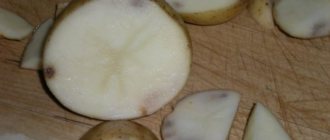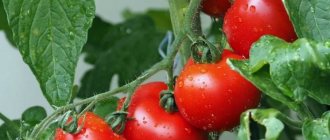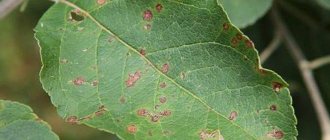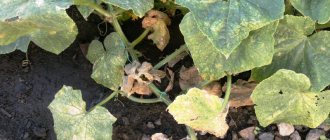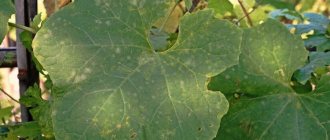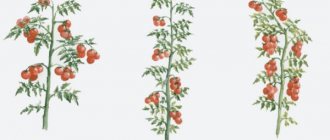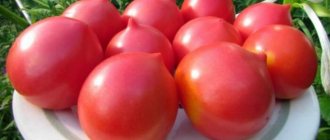When growing tomatoes, we often encounter various plant diseases that can significantly affect the future harvest.
It is important to identify the type of disease in time and immediately begin saving the plants.
Prevention will help prevent or facilitate the process of fighting the disease. The article talks about dealing with burns on leaves and stems.
What is it and what does it look like?
First, let's find out what types of burns there are and what they look like:
- chemical burn;
- sunburn.
With a chemical burn, most often with boric acid, white spots appear on leaves or fruits, or rather tissue necrosis. With sunburn, yellowing of the edges of the leaves is observed, followed by drying, curling and falling off.
- In the first case, this occurs due to excess concentration of the spraying composition and incorrect choice of weather conditions for this operation.
- Sunburn appears on seedlings that are not adapted to sunlight, as well as seedlings planted in open ground, unprotected from direct sunlight. These damages can also occur on fruits growing under the scorching sun. They look like yellow spots, which subsequently do not turn red and harden. On stems they appear as tissue necrosis.
Signs of overheating tomatoes
For high-quality development and abundant fruiting, tomatoes need a daytime temperature of 20-25⁰C, and a night temperature of 16-18⁰C. If the temperature in the greenhouse rises above 30-35⁰C and stays at this level for over 4-5 hours, then the tomatoes begin to feel discomfort and the first signs of overheating appear.
- The leaf blades become pale, as if burned out in the sun.
- The buds, flowers, and ovaries begin to fall off.
- The growth of the tomato bush is slowing down.
If plants are exposed to elevated temperatures for a long time, burn spots appear on the leaves and they begin to curl. Fruits of fruiting tomatoes also suffer. Light spots, cracks, and sometimes rot appear on them. The pulp becomes coarse and unpalatable.
An increase in temperature in the greenhouse to 38-42⁰C causes the leaves to fall, the stem loses vital juices - the plant dies.
When tomatoes in a greenhouse experience overheating, they are forced to spend all their energy on breathing, as a result of which their development stops.
Photos of seedlings and fruits
In the photo below you can see sun and chemical burns on tomato seedlings and adult plants.
Black bacterial spot
On the leaves of tomato seedlings, the symptoms of black bacterial spot look like small spots of light green color. But soon they enlarge and turn brown.
Bacteria penetrate into the leaves through natural openings and through any mechanical damage. The bacterium begins to actively develop at high humidity and temperatures above +25 degrees.
Control measures:
- Cleaning the soil from plant residues in which bacteria can persist;
- Treating the seed;
- Do not thicken the plantings;
- Maintain crop rotation;
- Remove affected leaves;
- Treat tomato seedlings with the following preparations: “Fitosporin - M”, “Baktofit”, “Gamair”.
In difficult cases, go to chemical means of control: “Hom”, “Oxychom”, Bordeaux mixture.
Causes of Sun Damage
Plants get sunburn due to powerful ultraviolet irradiation , that is, prolonged exposure to the scorching sun. This occurs at temperatures of 40 degrees and above. Seedlings, plants planted in open ground, in a greenhouse and fruits can be burned.
As a rule, the lower leaves are more resistant to this effect, since they are in the shadow of the upper ones. If tomato bushes are subjected to severe pinching, the fruits do not have leaf protection and are therefore more susceptible to burns. It looks like whitish spots on tomatoes and withered edges on leaves.
Burnt leaves and fruits stop developing . The tomatoes become dense, lumpy and tasteless.
Places damaged by burns are a conductor of various diseases.
Reasons for burning tomatoes
Tomatoes affected by overheating may have several reasons.
- The seedlings were planted in closed ground without prior preparation for changing growing conditions.
- At home, tomatoes were grown on northern windows.
- High temperatures in the greenhouse can lead to burns due to insufficient ventilation of the room.
- Lack of control over thermometer readings.
- Forced absence of a gardener at a summer cottage.
Once the problem is discovered, immediate measures must be taken to restore (if possible) the affected seedlings.
What to do if tomatoes are injured, how to resuscitate them?
Methods and means of resuscitating plants from burns will depend on the degree of damage. It is impossible to restore burnt leaves and fruits. We'll show you how to restore tomatoes after moderate damage.
After a chemical burn, water the leaves with clean, not cold water . The following activities carried out to restore plants include various feedings to increase green mass.
Inorganic:
- nitrogen;
- complex mineral fertilizers (nitroammophoska, ammonium sulfate and others).
Or one of the organic fertilizers:
- herbal nettle infusion;
- chicken droppings.
Burnt tomatoes need to be removed from the bush , as their affected areas will quickly become susceptible to other diseases. This will lead to crop loss.
Non-communicable diseases
Watering errors
Often signs of suboptimal watering are confused with infectious diseases.
With a lack of moisture, tomatoes slow down their growth and shed ovaries and flowers abundantly. The leaves droop, turn yellow at the tips and wrinkle. To bring the plants back to their senses, it is not recommended to fill them with large amounts of water at once. It’s better to give them some settled water and after a couple of days water them as they should.
Excess water also affects tomato development. Most often, stagnation of water causes rotting of the roots, the leaves on the tomatoes fade (old and young at the same time) and they begin to fall off. Watery or brown spots may appear at the root collar. If it is immediately impossible to carry out drainage work in such areas, then it is better to replant the bushes, slightly cleaning the roots from rot.
Improper watering can lead to cracking of tomato fruits. This usually happens when, in the heat, summer residents suddenly appear on the site and, seeing a dull picture in the garden, rush for a hose. Plants experience shock when water is suddenly supplied and quickly deliver it to the ovaries. The covering tissues burst and infections can enter there. It happens that the tissues heal in time and create a new coating. It has been noticed that tomatoes are prone to cracking when overfed with mineral water.
Sunburn
Burnt areas on tomato fruits are whitish spots of varying sizes. It happens that solar radiation causes burns to a very large part of the fruit. Wounds that appear under the influence of rays dry out over time and do not allow the fruits to develop. Then they wither, and the taste of such fruits deteriorates greatly.
Treatment for vegetables in a greenhouse
Plants can also get sunburn in a greenhouse, even if all agrotechnical rules are followed.
If only the leaves are burnt, then they can be removed, but not all at once, so as not to expose the plant to even greater stress. After this, the bushes will recover, although the harvest date will be slightly delayed. If the stems and roots are burnt, the seedlings need to be replaced. To prevent this from happening, the optimal temperature regime must be maintained in the greenhouse : +23ºС – 25ºС during the day and + 18ºС at night. To do this, arrange through ventilation on both sides, and also open all the windows, which will save the plants from overheating, and at the same time from late blight.
Sometimes in summer there are very hot days. In this case, ventilation does not give an effective result. Shading can help. On hot days, the greenhouse can be covered with spunbond, newspapers, mesh, but always white.
The greenhouse can be painted with a chalk solution (mix chalk with water) or a flour solution (flour with milk). The main thing is that this composition washes off well and is easy to remove at the end of the heat.
If, nevertheless, the bushes in the greenhouse are burnt, they need to be watered thoroughly that day. This is done in the morning or evening hours so that the water does not evaporate quickly and settle on the walls in the form of condensation. For the same purpose, airing is done for 1 hour.
Helping plants when overheated
If tomatoes are burned in a greenhouse, they can still survive if measures are taken to restore them in a timely manner. The first step is to adjust the optimal temperature in the polycarbonate greenhouse. During the day it should be 22-25 degrees, and at night it is desirable that its level does not fall below 16-18 degrees. This night temperature allows the tomatoes to harden and more easily withstand possible daytime overheating. If the heat remains in the greenhouse at night, the quality and quantity of the fruit will deteriorate significantly.
It affects:
- plant growth;
- soil absorption of water and necessary elements;
- volume of harvest obtained;
- optimization of harvest time;
- control of plant diseases and more.
It is for this reason that owners of polycarbonate greenhouses must have a good understanding of what temperature regime is most optimal for the plant being grown, and be able to reduce the temperature in time.
To reduce the temperature in a polycarbonate greenhouse, it should be darkened to prevent direct sunlight. This is especially true for flowering plants. You can darken the greenhouse using a special darkening mesh, which is sold in any store that sells gardening supplies. This mesh is made from synthetic threads and foil and can have different cell sizes: the smaller their size, the less the mesh allows sunlight to pass through. Such measures will reduce the air temperature by 5-7 degrees
However, caution should be exercised: it is impossible to darken the greenhouse for a long time, as this will lead to a decrease in the consumption of carbon dioxide by the leaves
Types of tomato diseases.
At high temperatures, care should be taken to ensure that there are drafts in the greenhouse. They will help cool the tomato leaves and give the plants a chance to grow and bear fruit normally. Drafts can be created by periodically opening the windows in the doors of the greenhouse. If for some reason the windows cannot be opened during the day, you should think about automatic ventilators
When creating a draft in the greenhouse, it is important to make sure that only the upper and middle tiers are blown, and the lower one remains closed, since blowing through the bottom of the greenhouse can lead to drying out of the soil, which will create additional problems
When tomatoes overheat, it is useful to ensure that the air is saturated with carbon dioxide. This can be done by placing a container with fermenting manure in the greenhouse and filling it halfway with water. This will have a beneficial effect on the nutrition of tomatoes. For the same purpose, you can use dry ice, which must be placed in the greenhouse in a ratio of 10-20 grams per cubic meter. Such measures are especially useful on hot sunny days, when plants need increased amounts of carbon dioxide.
Much attention should be paid to watering tomatoes. They should be watered once or twice a week; on hot days, watering may be required more often, while avoiding excessive soil moisture
In cloudy weather, water consumption when watering is 1-2 liters per plant, in sunny weather - 6-10 liters. Tomatoes in a greenhouse cannot be watered during the day; this leads to increased air humidity and negatively affects the cooling process of the leaves. In addition, high humidity can cause the development of many tomato diseases. The most optimal time for watering tomatoes is considered to be early morning; If it is not possible to water the tomatoes in the morning, this should be done in the evening.
When tomatoes are overheated, it is useful to spray them with a weak solution of zinc salts. This should be done every day until the plants return to normal. This simple technique will significantly increase the heat resistance of plants.
3 years ago by Alexander Lebedev
5 Replies
If the greenhouse is unheated, this did not save the plants from being damaged by the cold. 3 years ago by Anzor Tarkanov0 votes Possibly from the bright sun, this happens to me with peppers, it was necessary to shade them. Nothing, they will recover.3 years ago from Jack Daniels0 votesProbably sun-heatstroke.
If it doesn’t go away (I don’t know about tomatoes, I don’t know about eggplants), then stepsons will come out of the axils, you can even cut off the tops to have more strength, then leave the strongest shoots, one or two at most. This happened to me, I put the seedlings under the film and probably burned, only the stems remained, I cut them off, leaving 2 lower internodes, the stepsons started. 3 years ago from Lyudmila Karashchuk (Isaeva) 0 votes Stuffiness and heat in the greenhouse! Ventilate more often. Although, I’m afraid it’s hardly possible to save the seedlings (If they had frozen, they would have turned black, not white. 3 years ago from Ian
Prevention
For their garden plots, gardeners usually grow tomato seedlings themselves. Already at this time, you need to take care of hardening the plants from burns.
- It is necessary to gradually accustom the plants to the sun, expose them to open sunlight, starting from 1 hour and extending to 3 hours in the morning and evening. Then the time should be increased further and the process finally completed by bringing the plants into the house (transferred from the loggia) only at night.
- After planting in open ground or a greenhouse, you need to think about shading during the scorching sun.
A medium-density covering material may be suitable for these purposes. It is better to choose white, because... it allows some sunlight to pass through. But please note that if you completely cover the plants, the temperature under the covering material will be even higher than outside, so you should try to shade only the upper parts of the plants, which are more susceptible to burns on hot days. - Plants need to be watered only at the roots and in the evening.
- Spraying them with biostimulants will help increase the immunity of tomatoes.
- To protect fruits from burns, it is necessary to prevent overheating of the fruit, which occurs when there is insufficient foliage. In other words, if it’s a hot summer, then you shouldn’t rush to remove the extra stepsons.
Advice from experienced gardeners
Such misfortunes as burns of leaves and fruits of tomatoes are not encountered by experienced gardeners. Thanks to their skills and knowledge, they carry out all the necessary protective procedures in a timely manner. Here are some of them:
- select varieties of tomatoes adapted to given weather conditions;
- do not water the plants during the daytime, as drops of water under the bright rays of the sun focus them like lenses;
- if the leaves of the tomatoes still get burned, then they need to be sprayed with Epin solution;
- cover the plantings with spunbond (covering material);
- Place a container with diluted mullein in the greenhouse; carbon dioxide vapor will accelerate the appearance of green mass after removing the burnt leaves;
- do not treat tomato bushes with boric acid in clear weather, as the water quickly evaporates and the concentration of the solution increases;
- It is best to dilute boric acid at a water temperature of +50 ºС, in this case there will be no undissolved suspension left and it will not burn the leaves;
- Do not increase the concentration of the solution under any circumstances, adhere to the recommended interval between treatments, and do not spray more than three times per season;
- protect the soil from overheating by mulching with agrofibre or other covering materials;
- provide shading of the area or greenhouse.
Growing tomatoes is an easy task that requires a little knowledge and diligence. So that your work is not overshadowed by a bad harvest, carefully re-read this article and you can get rid of one problem. Tomato burns greatly impair the appearance of the fruit and its taste, and leaf burns will significantly reduce your yield. Compliance with agricultural technology and strict adherence to instructions for medications will help to avoid this.
What not to do if you have sunburn
Complications from sunburn often occur due to improper treatment. So that they pass without consequences:
- do not apply ice to burned areas, do not take a cold shower - a sharp temperature change will accelerate the development of the inflammatory process;
- do not puncture blisters with a needle or other sharp objects - this increases the risk of infection;
- do not wipe the skin with alcohol-containing solutions - it needs to be moisturized, and alcohol dries it out, which will increase peeling;
- do not lubricate burned areas with olive, sunflower or other vegetable oils - they form a greasy film, which interferes with normal air exchange and natural cooling;
- if blisters appear, there are wounds, acne - do not apply fermented milk products;
- Do not use hard washcloths or peelings to speed up exfoliation, as you may injure the skin.
At this time, you need to soften it, moisturize it and protect it from ultraviolet radiation with sunscreen or thick clothing, do not use scrubs, hard washcloths, do not visit the sauna or take hot baths.
